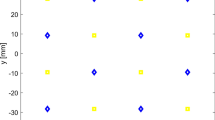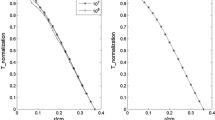Abstract
In this study, time resolved (TR) Monte Carlo (MC) simulation program code was run to generate photon fluencies with increasing time steps. TR MC simulation was performed for ten time series from 4 ps to 52 ps. Generated photon fluencies were transferred to the image analysis programming platform. Imaging device geometry was created for test purpose in image reconstruction programming platform environment. Forward model weight matrix functions were calculated during each time period for 38 sources, and 38 detectors according to the back-reflected imaging geometry. A homogenous phantom, which simulated tissue, was chosen. Depending on the homogeneous tissue optical properties, such as tissue absorption coefficient μa, and tissue scattering coefficient μs, photons emitted from the laser source positions; migrated differently inside the imaging tissue. Photons migrate inside the tissue by some multiplication factor of ps depending on the tissue type for each 100-micrometer vertical distance. Superficial photons come photodetector point fast, depend on the source-detector neighborhood distances and tissue optical properties, respectively. Time resolved diffuse optic tomography (TRDOT) imaging systems are an emerging biomedical optic imaging modality due to progressive electronic technologies are helping to build the systems faster and cheap. As such, emerging microelectronic technology is giving important access to design and implement compact laser sources and photodetector units. Vertical cavity surface emitting light (VCSEL) as laser source and single photon avalanche diode (SPAD) arrays as photodetector units are becoming in common use as important hardware tools for designers and researchers in this field. TR diffuse photon analysis should be done routinely for better understanding of TRDOT devices. Hence, MC simulation driven TR photon fluence analysis was done for such a purpose in this study.
Similar content being viewed by others
References
M.S. Patterson, B. Chance and B. C. Wilson, Applied Optics 28, 2331 (1989).
D. S. Elson, J. Siegel, S. E. D. Webb, S. Lévêque-Fort, M. J. Lever, P. M. W. French, K. Lauritsen, M. Wahl and R. Erdmann, Optics Letters 27, 1409 (2002).
D. Grosenick, K. T. Moesta, H. Wabnitz, J. Mucke, C. Stroszczynski, R. Macdonald, P. M. Schlag and H. Rin-neberg, Applied Optics 42, 3170 (2003).
J. Selb, A.M. Dale and D.A. Boas, Opt. Express 15, 16400 (2007).
O. K. Dudko, G. H. Weiss and V. Chernomordik, Phys. Med. Biol. 51, 4719 (2006).
C. Das, A. Trivedi, K. Mitra and T. Vo-Dinh, Applied Optics 42, 5173 (2003).
Y. Ueda, K. Ohta and Y. Yamashita, Optical Review 12, 334 (2005).
M. Sakami and K. Mitra, Optics Letters 27, 336 (2002).
S. R. Arridge, J. C. Hebden, M. Schweiger, F. Schmidt, M. Fry, E. M. C. Hillman, H. Dehghani and D. T. Delpy, International Journal of Imaging Systems and Technology 11, 2 (2000).
E. Ohmae, Y. Ouchi, M. Oda, T. Suzuki, S. Nobesawa, T. Kanno, E. Yoshikawa, M. Futatsubashi, Y. Ueda, H. Okada and Y. Yamashita, NeuroImage 29, 697 (2006).
D.T. Delpy, M. Cope, P. Zee, S. Arridge, S. Wray and J. Wyatt, Phys. Med. Biol. 33, 1433 (1988).
P. Poulet, C. V. Zint, M. Torregrossa, W. Uhring and B. Cunin, Comparison of Two Time-Resolved Detectors for Diffuse Optical Tomography: Photomultiplier Tube-Time-Correlated Single Photon Counting and Multichannel Streak Camera, Proc. Optical Tomography and Spectroscopy of Tissue SPIE, 154 (2003).
W. Uhring, C. V. Zint and J. Bartringer, A Low Cost High Repetition Rate Picosecond Laser Diode Pulse Generator, Proc. Semiconductor Lasers and Laser Dynamics SPIE, 583 (2004).
S. Landgraf, Application of Laser Diodes and Ultrabright Light Emitting Diodes for Static and Time-Resolved Optical Methods in Physical Chemistry, Handbook of Luminescence, Display Materials and Devices 3, 372 (2003).
S. L. Jacques, Time-resolved Monte Carlo, ECE532 Biomedical Optics, (1998).
https://omlc.org/classroom/ece532/class4/trmc/trmc.c.
Author information
Authors and Affiliations
Corresponding author
Rights and permissions
About this article
Cite this article
Kazanci, H.O., Niitsu, K. Monte Carlo simulation driven time resolved photon fluence analysis. Optoelectron. Lett. 16, 237–240 (2020). https://doi.org/10.1007/s11801-020-9060-y
Received:
Revised:
Published:
Issue Date:
DOI: https://doi.org/10.1007/s11801-020-9060-y




